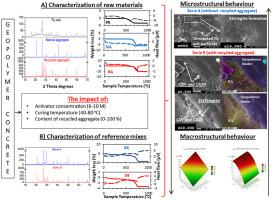Journal of Building Engineering ( IF 6.7 ) Pub Date : 2021-09-15 , DOI: 10.1016/j.jobe.2021.103317 Edyta Pawluczuk 1 , Katarzyna Kalinowska-Wichrowska 1 , José Ramón Jiménez 2 , José María Fernández-Rodríguez 3 , David Suescum-Morales 2

|
Geopolymer concrete is a more environmentally friendly alternative than conventional concrete because its production does not need cement. Instead, waste materials such as fly ash, rice husk ash, slag, etc. are used. This research studies the effect of the activator concentration (6–10 M), curing temperature (40–80 °C) and incorporation ratio of thermally and mechanically treated recycled aggregate (0–100%) on changes in the macrostructural properties of geopolymer concrete. All raw materials were previously characterized by thermogravimetric and differential thermal analysis, X-ray fluorescence and X-ray diffraction. Furthermore, a microstructural characterization was carried out on two geopolymer concrete mixes used as reference: one made with a natural aggregate and the other with a treated recycled aggregate. The interfacial transition zone between the treated recycled aggregate/natural aggregate and geopolymer paste was studied using SEM-EDS. A beneficial effect of the treated recycled aggregates on the compressive strength of geopolymer concrete was observed due to formation of silicate hydrated gel (CSH) and calcium aluminate silicate hydrated gel (CASH). However, a slight increase in the water absorption of geopolymer concrete and the mass of peels after 28 freezing and thawing cycles occurred because of the presence of residual porous cement mortar on the treated recycled aggregate surface.
中文翻译:

具有处理过的再生骨料的地质聚合物混凝土:宏观和微观结构行为
地质聚合物混凝土是一种比传统混凝土更环保的替代品,因为它的生产不需要水泥。而是使用粉煤灰、稻壳灰、矿渣等废料。本研究研究了活化剂浓度 (6–10 M)、固化温度 (40–80 °C) 和热处理和机械处理再生骨料的掺入比例 (0–100%) 对地聚合物混凝土宏观结构性能变化的影响. 所有原材料之前都通过热重分析和差热分析、X 射线荧光和 X 射线衍射进行了表征。此外,对用作参考的两种地质聚合物混凝土混合物进行了微观结构表征:一种用天然骨料制成,另一种用处理过的再生骨料制成。使用 SEM-EDS 研究了处理过的再生骨料/天然骨料和地质聚合物糊之间的界面过渡区。由于形成了硅酸盐水合凝胶(CSH)和硅酸铝钙水合凝胶(CASH),观察到处理过的再生骨料对地质聚合物混凝土的抗压强度的有益影响。然而,由于处理过的再生骨料表面存在残留的多孔水泥砂浆,地聚合物混凝土的吸水率和 28 次冻融循环后的剥落质量略有增加。由于形成了硅酸盐水合凝胶(CSH)和硅酸铝钙水合凝胶(CASH),观察到处理过的再生骨料对地质聚合物混凝土的抗压强度的有益影响。然而,由于处理过的再生骨料表面存在残留的多孔水泥砂浆,地聚合物混凝土的吸水率和 28 次冻融循环后的剥落质量略有增加。由于形成了硅酸盐水合凝胶(CSH)和硅酸铝钙水合凝胶(CASH),观察到处理过的再生骨料对地质聚合物混凝土的抗压强度的有益影响。然而,由于处理过的再生骨料表面存在残留的多孔水泥砂浆,地聚合物混凝土的吸水率和 28 次冻融循环后的剥落质量略有增加。











































 京公网安备 11010802027423号
京公网安备 11010802027423号